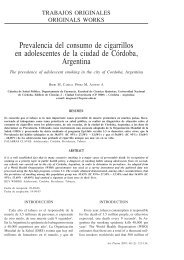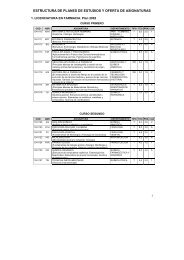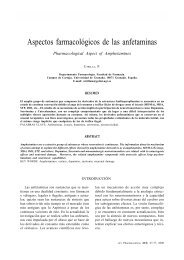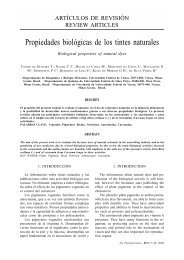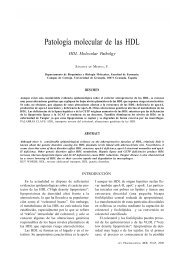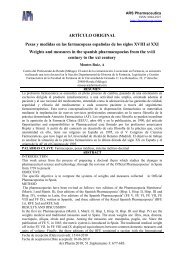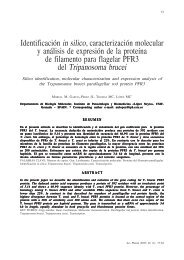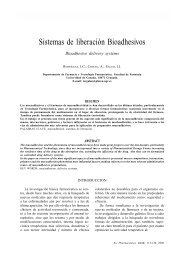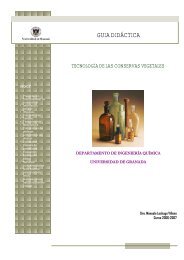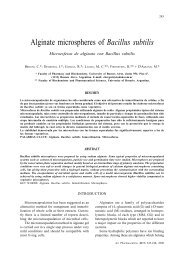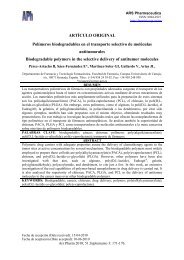Actividad inmunomoduladora del extracto de metanol de la cabeza ...
Actividad inmunomoduladora del extracto de metanol de la cabeza ...
Actividad inmunomoduladora del extracto de metanol de la cabeza ...
You also want an ePaper? Increase the reach of your titles
YUMPU automatically turns print PDFs into web optimized ePapers that Google loves.
ACTIVIDAD INMUNOMODULADORA DEL EXTRACTO DE METANOL DE LA CABEZA FLORAL...<br />
<strong>Actividad</strong> <strong>inmunomodu<strong>la</strong>dora</strong> <strong><strong>de</strong>l</strong> <strong>extracto</strong><br />
<strong>de</strong> <strong>metanol</strong> <strong>de</strong> <strong>la</strong> <strong>cabeza</strong> floral <strong>de</strong> Sphaeranthus<br />
indicus Linn<br />
Immunomodu<strong>la</strong>tory activity of methanol extract of flower-heads of<br />
Sphaeranthus indicus Linn<br />
BAFNA AR, AND MISHRA SH.*<br />
Pharmacy Department, Faculty of Technology and Engineering,<br />
The M.S.University of Baroda,Vadodara-390002,Gujarat, India<br />
*Dirección para correspon<strong>de</strong>ncia: Dr.S.H.Mishra, Pharmacy <strong>de</strong>partment, Faculty of Technology and Engineering,<br />
The M.S.University of Baroda, Vadodara-390002. Gujarat, India.<br />
Correo electrónico:shmishra48@rediffmail.com<br />
RESUMEN<br />
El <strong>extracto</strong> <strong>de</strong> <strong>metanol</strong> y sus fracciones <strong>de</strong> éter <strong>de</strong> petróleo, cloroformo y <strong>metanol</strong> sobrante <strong>de</strong> <strong>la</strong>s <strong>cabeza</strong>s florales<br />
<strong>de</strong> Sphaeranthus indicus Linn <strong>de</strong>mostraron su eficacia al aumentar <strong>la</strong> actividad fagocítica, el título <strong>de</strong> anticuerpos<br />
<strong>de</strong> <strong>la</strong> hemaglutinación y <strong>la</strong> hipersensibilidad <strong>de</strong> tipo retardado, mientras que sólo <strong>la</strong> fracción <strong>de</strong> <strong>metanol</strong> restante<br />
resultó activa en <strong>la</strong> normalización <strong>de</strong> los niveles <strong>de</strong> leucocitos totales en el caso <strong>de</strong> <strong>la</strong> mielosupresión inducida por<br />
ciclofosfamida en ratones. Por tanto, el presente estudio reve<strong>la</strong> que el fármaco augura buenos resultados como agente<br />
inmunomodu<strong>la</strong>dor, al actuar como estimu<strong>la</strong>nte <strong>de</strong> <strong>la</strong> inmunidad celu<strong>la</strong>r y humoral y <strong>de</strong> <strong>la</strong> función fagocítica.<br />
PALABRAS CLAVE: Sphaeranthus indicus. <strong>Actividad</strong> <strong>inmunomodu<strong>la</strong>dora</strong>. Hemaglutinación. Mielosupresión.<br />
ABSTRACT<br />
Methanol extract, its petroleum ether, chloroform and remaining methanol fractions, of flower heads of Sphaeranthus<br />
indicus Linn. were found effective in increasing phagocytic activity, haemagglutination antibody titer and <strong><strong>de</strong>l</strong>ayed type<br />
hypersensitivity, whereas only remaining methanol fraction was found active in normalizing total WBC levels in case<br />
of cyclophosphami<strong>de</strong> induced myelosuppression in mice. Present study, therefore, reveals that the drug holds promise<br />
as immunomodu<strong>la</strong>tory agent, which acts by stimu<strong>la</strong>ting both humoral as well as cellu<strong>la</strong>r immunity and phagocytic<br />
function.<br />
KEY WORDS: Sphaeranthus indicus. Immunomodu<strong>la</strong>tory activity. Haemagglutination. Myelosuppression.<br />
INTRODUCCIÓN<br />
Los fármacos herbales son conocidos por sus<br />
propieda<strong>de</strong>s <strong>inmunomodu<strong>la</strong>dora</strong>s y por estimu<strong>la</strong>r<br />
<strong>de</strong> forma generalizada <strong>la</strong> inmunidad específica<br />
y no específica 1 . Muchas <strong>de</strong> <strong>la</strong>s p<strong>la</strong>ntas utilizadas<br />
en <strong>la</strong> medicina tradicional han <strong>de</strong>mostrado<br />
poseer activida<strong>de</strong>s <strong>inmunomodu<strong>la</strong>dora</strong>s. Algunas<br />
<strong>de</strong> estas p<strong>la</strong>ntas estimu<strong>la</strong>n tanto <strong>la</strong> inmunidad<br />
celu<strong>la</strong>r como <strong>la</strong> inmunidad humoral, mientras que<br />
otras sólo activan los componentes celu<strong>la</strong>res <strong><strong>de</strong>l</strong><br />
INTRODUCTION<br />
281<br />
Herbal drugs are known to possess immunomodu<strong>la</strong>tory<br />
properties and generally act by stimu<strong>la</strong>ting<br />
both specific and non-specific immunity<br />
1 . Many p<strong>la</strong>nts used in traditional medicine are<br />
reported to have immunomodu<strong>la</strong>ting activities.<br />
Some of these stimu<strong>la</strong>te both humoral and cell<br />
mediated immunity while others activate only<br />
the cellu<strong>la</strong>r components of the immune system,<br />
i.e. phagocytic function without affecting the<br />
Ars Pharmaceutica, 45:3; 281-291, 2004
282<br />
sistema inmunitario, es <strong>de</strong>cir, <strong>la</strong> función fagocítica<br />
sin afectar a <strong>la</strong> inmunidad celu<strong>la</strong>r o humoral.<br />
El <strong>extracto</strong> <strong>de</strong> hoja <strong>de</strong> Picrorhiza kurroa actúa<br />
como estimu<strong>la</strong>nte <strong>de</strong> <strong>la</strong> respuesta humoral y <strong>de</strong><br />
<strong>la</strong> función fagocítica <strong><strong>de</strong>l</strong> sistema reticuloendotelial.<br />
Algunas <strong>de</strong> estas p<strong>la</strong>ntas también actúan como<br />
supresores <strong>de</strong> <strong>la</strong> inmunidad celu<strong>la</strong>r y humoral 2,3 .<br />
Aproximadamente unas 34 p<strong>la</strong>ntas se i<strong>de</strong>ntifican<br />
como rasayanas en el sistema <strong>de</strong> medicina<br />
Ayurvedic <strong>de</strong> <strong>la</strong> India y presentan diversas propieda<strong>de</strong>s<br />
farmacológicas inmunoestimu<strong>la</strong>ntes,<br />
tónicas, neuroestimu<strong>la</strong>ntes, anti-envejecimiento,<br />
antibacterianas, antivirales, antireumáticas, anticancerígenas,<br />
adaptogénicas, antiestrés, etc. 4 La<br />
materia médica ayurvédica <strong>de</strong>dica una sección<br />
completa a los fármacos utilizados para mejorar<br />
<strong>la</strong> resistencia corporal titu<strong>la</strong>da ‘Rasayana’. Se<br />
i<strong>de</strong>ntificaron diversas p<strong>la</strong>ntas con actividad <strong>inmunomodu<strong>la</strong>dora</strong><br />
potencial, entre <strong>la</strong>s que se encontraban<br />
algunas con <strong>la</strong>s que ya se había emprendido<br />
<strong>la</strong> evaluación <strong>de</strong> sus activida<strong>de</strong>s en<br />
animales y, en cierta medida, en humanos. Asparagus<br />
racemosus, Azadirachta indica, Curcuma<br />
longa, Ocimum sanctum, Panax ginseng, Picrorrhiza<br />
kurroa, Tinospora cordifolia, Withania<br />
somnifera etc. son algunos ejemplos evi<strong>de</strong>ntes<br />
<strong>de</strong> p<strong>la</strong>ntas con una actividad prometedora. Aún<br />
quedan por investigar muchas más, lo que amplía<br />
<strong>la</strong>s posibilida<strong>de</strong>s para futuras investigaciones<br />
4 .<br />
Sphaeranthus indicus Linn. (Compositae) es<br />
una hierba que se encuentra principalmente en el<br />
sur <strong>de</strong> <strong>la</strong> India que posee propieda<strong>de</strong>s antiulcerosas,<br />
estomacales, estimu<strong>la</strong>ntes, curativas, pectorales,<br />
<strong>de</strong>mulcentes y emolientes <strong>de</strong> forma externa.<br />
Los médicos locales recomiendan el agua<br />
<strong>de</strong>sti<strong>la</strong>da preparada como el agua <strong>de</strong> rosas proce<strong>de</strong>nte<br />
<strong>de</strong> <strong>la</strong> hierba para <strong>la</strong>s afecciones biliares<br />
y <strong>la</strong> diseminación <strong>de</strong> varios tipos <strong>de</strong> tumores.<br />
Las flores (<strong>la</strong> <strong>cabeza</strong> floral) son muy apreciadas<br />
por sus propieda<strong>de</strong>s curativas, <strong>de</strong>purativas, febrífugas<br />
y tónicas, muy útiles como purificadoras<br />
<strong>de</strong> <strong>la</strong> sangre en patologías dérmicas. El fármaco<br />
es también muy útil para combatir <strong>la</strong> ictericia<br />
y <strong>la</strong>s secreciones uretrales. La presente investigación<br />
se realizó con el propósito <strong>de</strong> estudiar <strong>la</strong><br />
actividad <strong>inmunomodu<strong>la</strong>dora</strong> <strong><strong>de</strong>l</strong> <strong>extracto</strong> <strong>de</strong><br />
<strong>metanol</strong> <strong>de</strong> <strong>la</strong>s <strong>cabeza</strong>s florales <strong>de</strong> S.indicus y<br />
sus distintas fracciones mediante los métodos<br />
establecidos para justificar <strong>la</strong>s indicaciones tradicionales<br />
legadas por el fármaco como rasayana.<br />
Ars Pharmaceutica, 45:3; 281-291, 2004<br />
BAFNA AR, MISHRA SH.<br />
humoral or cell mediated immunity. Leaf extract<br />
of Picrorrhiza kurroa stimu<strong>la</strong>ted the humoral<br />
response and the phagocytic function of the reticuloendothelial<br />
system. Some of these p<strong>la</strong>nts<br />
also suppress both humoral and cell mediated<br />
immunity 2,3 .<br />
About 34 p<strong>la</strong>nts are i<strong>de</strong>ntified as rasayanas<br />
in Indian Ayurvedic system of medicine having<br />
various pharmacological properties such as immunostimu<strong>la</strong>nt,<br />
tonic, neurostimu<strong>la</strong>nt, antiageing,<br />
antibacterial, antiviral, antirheumatic, anticancer,<br />
adaptogenic, antistress etc. 4 . An entire section of<br />
materia medica of Ayurveda is <strong>de</strong>voted to drugs<br />
entitled as ‘Rasayana’ used for enhancement of<br />
body resistance 5 . Many p<strong>la</strong>nts with potential<br />
immunomodu<strong>la</strong>tory activity are reported, some<br />
of these have already been un<strong>de</strong>rtaken for evaluation<br />
of their activities in animals, and also to<br />
some extent in humans. Some g<strong>la</strong>ring examples<br />
with promising activity are Asparagus racemosus,<br />
Azadirachta indica, Curcuma longa, Ocimum<br />
sanctum, Panax ginseng, Picrorrhiza kurroa,<br />
Tinospora cordifolia, Withania somnifera<br />
etc. A lot more are still to be explored and offer<br />
scope for further investigation 4 .<br />
Sphaeranthus indicus Linn. (Compositae) is a<br />
herb found mostly in southern part of India used<br />
as bitter stomachic, stimu<strong>la</strong>nt, alterative, pectoral<br />
and <strong>de</strong>mulcent, and externally emollient.<br />
Distilled water prepared like rose water from the<br />
herb is recommen<strong>de</strong>d by local physicians for<br />
bilious affections and for dispersions of various<br />
kinds of tumours. Flowers (flower heads) are<br />
highly esteemed as alteratives, <strong>de</strong>puratives, refrigerants<br />
and tonics, useful as blood purifiers in<br />
skin diseases. The drug is also useful in urethral<br />
discharges and in jaundice 6 . The present investigation<br />
was aimed to study the immunomodu<strong>la</strong>tory<br />
activity of methanol extract of flower heads<br />
of S.indicus and its different fractions using reported<br />
methods in or<strong>de</strong>r to justify the traditional<br />
c<strong>la</strong>ims endowed upon the drug as rasayana.<br />
MATERIALS AND METHODS<br />
Animals: Swiss albino mice of either sex,<br />
weighing 20-25 gms, household in standard conditions<br />
of temperature, humidity and light were<br />
used. They were fed with standard ro<strong>de</strong>nt diet<br />
and water ad libitum.
IMMUNOMODULATORY ACTIVITY OF METHANOL EXTRACT OF FLOWER-HEADS OF...<br />
MATERIALES Y MÉTODOS<br />
Animales: Ratones albinos suizos <strong>de</strong> ambos<br />
sexos, con un peso <strong>de</strong> entre 20 y 25 g., mantenidos<br />
en condiciones estándar <strong>de</strong> temperatura,<br />
humedad y luz. Fueron alimentados con una dieta<br />
estándar <strong>de</strong> roedor y agua ad libitum.<br />
Material <strong>de</strong> <strong>la</strong> p<strong>la</strong>nta y preparación <strong><strong>de</strong>l</strong><br />
<strong>extracto</strong>: Se recogieron <strong>cabeza</strong>s florales frescas<br />
<strong>de</strong> S.indicus proce<strong>de</strong>ntes <strong>de</strong> los jardines <strong>de</strong> <strong>la</strong><br />
ciudad y se autenticaron en el Departamento <strong>de</strong><br />
botánica <strong>de</strong> <strong>la</strong> M.S.University, Baroda. La maceración<br />
<strong>de</strong> <strong>la</strong>s <strong>cabeza</strong>s florales disecadas al aire<br />
<strong>de</strong> S.indicus proporcionó un 6,65% <strong>de</strong> <strong>extracto</strong><br />
<strong>de</strong> <strong>metanol</strong> (w/w). El <strong>extracto</strong> <strong>de</strong> <strong>metanol</strong> obtenido<br />
<strong>de</strong> este modo se fraccionó por maceración<br />
en disolventes <strong>de</strong> distintas po<strong>la</strong>rida<strong>de</strong>s como el<br />
éter <strong>de</strong> petróleo, el benceno, el cloroformo y el<br />
<strong>metanol</strong>. Todas sus respectivas fracciones se<br />
concentraron al vacío y se utilizaron para el cribado<br />
farmacológico y fitoquímico. El <strong>extracto</strong><br />
<strong>de</strong> <strong>metanol</strong> resultó positivo en <strong>la</strong>s pruebas <strong>de</strong><br />
alcaloi<strong>de</strong>s, felónicos, esteroi<strong>de</strong>s, terpenoi<strong>de</strong>s y<br />
carbohidratos. Las fracciones <strong>de</strong> cloroformo,<br />
benceno y éter <strong>de</strong> petróleo resultaron positivas<br />
en <strong>la</strong>s pruebas <strong>de</strong> terpenoi<strong>de</strong>s y esteroi<strong>de</strong>s, mientras<br />
que <strong>la</strong> fracción <strong>de</strong> <strong>metanol</strong> resultó positiva<br />
en <strong>la</strong>s pruebas <strong>de</strong> alcaloi<strong>de</strong>s, felónicos y carbohidratos<br />
en el cribado fitoquímico 7 .<br />
Muestras <strong>de</strong> prueba: Las cantida<strong>de</strong>s pesadas<br />
<strong>de</strong> los <strong>extracto</strong>s <strong>de</strong> prueba se suspendieron<br />
en un 1% <strong>de</strong> carboximetilcelulosa <strong>de</strong> sodio para<br />
preparar <strong>la</strong>s formas <strong>de</strong> dosificación a<strong>de</strong>cuadas.<br />
A los animales contro<strong>la</strong>dos se les proporcionó<br />
un volumen equivalente <strong>de</strong> carboximetilcelulosa<br />
<strong>de</strong> sodio como vehículo. La ciclofosfamida se<br />
utilizó como inmunosupresor estándar.<br />
Suspensión <strong>de</strong> tinta <strong>de</strong> carbón: Se diluyó tinta<br />
Pelican AG, Germany ocho veces con solución<br />
salina y se utilizó para <strong>la</strong> prueba <strong>de</strong> <strong>de</strong>puración<br />
<strong><strong>de</strong>l</strong> carbón en una dosis <strong>de</strong> 10µl/gm <strong>de</strong> peso<br />
corporal <strong>de</strong> los ratones.<br />
Los eritrocitos <strong>de</strong> cor<strong>de</strong>ro se <strong>la</strong>varon tres veces<br />
en solución salina normal y se ajustaron a una<br />
concentración <strong><strong>de</strong>l</strong> 20% para <strong>la</strong> inmunización y<br />
<strong><strong>de</strong>l</strong> 1% para <strong>la</strong> prueba como antígeno.<br />
283<br />
P<strong>la</strong>nt material and extract preparation: Fresh<br />
flower heads of S.indicus were collected from<br />
the outfield of city, and were authenticated in<br />
Botany Department of M.S.University, Baroda.<br />
Maceration of air-dried, pow<strong>de</strong>red flower heads<br />
of S.indicus affor<strong>de</strong>d 6.65% methanol extract (w/<br />
w). Methanol extract so obtained was then fractionated<br />
by maceration into different po<strong>la</strong>rity<br />
solvents like petroleum ether, benzene, chloroform<br />
and methanol. All respective fractions were<br />
concentrated un<strong>de</strong>r vacuum and used for phytochemical<br />
and pharmacological screening. Methanol<br />
extract gave positive tests for alkaloids, phenolics,<br />
steroids, terpenoids and carbohydrates. Petroleum<br />
ether, benzene and chloroform fractions<br />
gave positive tests for terpenoids and steroids<br />
whereas methanol fraction gave positive tests for<br />
alkaloids, phenolics and carbohydrates on phytochemical<br />
screening 7 .<br />
Test samples: Weighed quantities of test<br />
extracts were suspen<strong>de</strong>d in 1% sodium carboxy<br />
methylcellulose to prepare suitable dosage form.<br />
The control animals were given an equivalent<br />
volume of sodium carboxy methylcellulose vehicle.<br />
Cyclophosphami<strong>de</strong> was used as a standard<br />
immunosuppressant.<br />
Carbon ink suspension: Pelican AG, Germany,<br />
ink was diluted eight times with saline and used<br />
for carbon clearance test in a dose of 10µl/gm<br />
body weight of mice.<br />
Sheep red blood cells (SRBCs) were washed<br />
with three times in normal saline and adjusted to<br />
a concentration 20% for immunization and 1%<br />
for challenge as Antigen.<br />
Phagocytic activity<br />
METHODS<br />
Phagocytic in<strong>de</strong>x was <strong>de</strong>termined as per the<br />
method reported by Gonda et al. 8 Mice were<br />
divi<strong>de</strong>d into 11 groups, of six animals each. The<br />
control group received 1.0 % sodium carboxy<br />
methylcellulose solution only as vehicle; while<br />
animals of the treatment groups were given test<br />
extracts (100 and 200 mg/kg, p.o.) in 1.0 % sodium<br />
carboxy methyl cellulose daily for 5 days. Carbon<br />
ink suspension was injected via tail vein to<br />
each mouse after 48 hours of 5 days treatment.<br />
Blood samples were drawn from orbital vein at<br />
Ars Pharmaceutica, 45:3; 281-291, 2004
284<br />
<strong>Actividad</strong> fagocítica<br />
MÉTODOS<br />
El índice fagocítico se <strong>de</strong>terminó mediante el<br />
método establecido por Gonda et al. 8 Los ratones<br />
se dividieron en 11 grupos con seis animales<br />
cada uno. El grupo <strong>de</strong> control sólo recibió un<br />
1,0% <strong>de</strong> solución <strong>de</strong> carboximetilcelulosa <strong>de</strong> sodio<br />
como vehículo, mientras que a los animales <strong>de</strong><br />
los grupos <strong>de</strong> tratamiento se les administraron<br />
los <strong>extracto</strong>s <strong>de</strong> prueba (100 y 200 mg/kg, vía<br />
oral) en un 1,0% <strong>de</strong> caborximetilcelulosa <strong>de</strong> sodio<br />
diariamente durante 5 días. A cada ratón se le<br />
inyectó <strong>la</strong> suspensión <strong>de</strong> tinta <strong>de</strong> carbón a través<br />
<strong>de</strong> <strong>la</strong> vena <strong>de</strong> <strong>la</strong> co<strong>la</strong> 48 horas <strong>de</strong>spués <strong><strong>de</strong>l</strong> tratamiento<br />
<strong>de</strong> 5 días. Se extrajeron muestras <strong>de</strong><br />
sangre <strong>de</strong> <strong>la</strong> vena orbital a los 0 y 15 minutos.<br />
La sangre (25-µl) se mezcló con un 0,1% <strong>de</strong><br />
carbonato sódico (2 ml) y se sometió a <strong>la</strong> <strong>de</strong>terminación<br />
<strong>de</strong> <strong>de</strong>nsida<strong>de</strong>s ópticas a 660 nm.<br />
El índice fagocítico (K) se calculó mediante<br />
<strong>la</strong> siguiente ecuación:<br />
K= (In OD 1 -In OD 2 ) / (t 2 -t 1 )<br />
don<strong>de</strong> OD 1 y OD 2 son <strong>la</strong>s <strong>de</strong>nsida<strong>de</strong>s ópticas<br />
en los momentos t 1 and t 2 , respectivamente.<br />
Mielosupresión inducida por ciclofosfamida<br />
La mielosupresión inducida por ciclofosfamida<br />
se estudió <strong>de</strong> acuerdo con el método <strong>de</strong>scrito<br />
por Manjarekar et al. 9 Los animales se dividieron<br />
en 12 grupos <strong>de</strong> seis animales cada uno. El<br />
grupo <strong>de</strong> control y el grupo <strong>de</strong> <strong>la</strong> ciclofosfamida<br />
recibieron un 1,0% <strong>de</strong> solución <strong>de</strong> carboximetilcelulosa<br />
<strong>de</strong> sodio sólo como vehículo diariamente<br />
durante 13 días, mientras que a los animales<br />
<strong>de</strong> los grupos <strong>de</strong> tratamiento se les administraron<br />
los <strong>extracto</strong>s <strong>de</strong> prueba (100 y 200 mg/kg,<br />
vía oral) en un 1,0% <strong>de</strong> caborximetilcelulosa <strong>de</strong><br />
sodio diariamente durante 13 días. Los días 11,<br />
12 y 13, a todos los animales excepto a los <strong><strong>de</strong>l</strong><br />
grupo <strong>de</strong> control se les inyectó ciclofosfamida<br />
(30 mg/kg, intraperitoneal) 1 hora <strong>de</strong>spués <strong>de</strong> <strong>la</strong><br />
administración <strong>de</strong> los <strong>extracto</strong>s. Las muestras <strong>de</strong><br />
sangre se extrajeron el día 14 y se <strong>de</strong>terminó el<br />
recuento <strong>de</strong> leucocitos totales.<br />
Ars Pharmaceutica, 45:3; 281-291, 2004<br />
BAFNA AR, MISHRA SH.<br />
0 and 15min. Blood (25-µl) was mixed with 0.1<br />
% sodium carbonate (2 ml) and subjected for<br />
<strong>de</strong>termination optical <strong>de</strong>nsities at 660 nm.<br />
The phagocytic in<strong>de</strong>x K, was calcu<strong>la</strong>ted by<br />
using following equation:<br />
K= (In OD 1 -In OD 2 ) / (t 2 -t 1 )<br />
where OD 1 and OD 2 are the optical <strong>de</strong>nsities<br />
at times t 1 and t 2 , respectively.<br />
Cyclophosphami<strong>de</strong> induced Myelosuppression<br />
Cyclophosphami<strong>de</strong> induced myelosuppression<br />
was studied according to the method <strong>de</strong>scribed<br />
by Manjarekar et al. 9 Animals were divi<strong>de</strong>d into<br />
12 groups of six animals each. The control group<br />
and cyclophosphami<strong>de</strong> group received 1.0 %<br />
sodium carboxy methylcellulose solution only as<br />
vehicle daily for 13 days while animals in treatment<br />
groups were given the test extracts (100<br />
and 200 mg/kg, p.o.) in 1.0 % sodium carboxy<br />
methyl cellulose daily for 13 days. On days 11,<br />
12, 13 all the animals except in the control group<br />
were injected with cyclophosphami<strong>de</strong> (30mg/kg,<br />
i.p.) 1 hour after administration of the extracts.<br />
Blood samples were collected on day 14 and total<br />
white blood cell (WBC) count was <strong>de</strong>termined.<br />
Humoral antibody (HA) titre and <strong><strong>de</strong>l</strong>ayed type<br />
hypersensitivity (DTH) response:<br />
The method <strong>de</strong>scribed by Puri et al. 10 was<br />
adopted. Animals were divi<strong>de</strong>d into 11 groups<br />
of six animals each. The control group received<br />
1.0 % sodium carboxy methylcellulose solution<br />
only as vehicle; while animals in the treatment<br />
groups were given the test extracts (100 and 200<br />
mg/kg, p.o.) in 1.0 % sodium carboxy methyl<br />
cellulose daily for 7 days. The animals were<br />
immunized by injecting 0.1 ml of 20% of fresh<br />
sheep red blood cells suspension intraperitoneally<br />
on 0 day. Blood samples were collected in<br />
micro centrifuge tubes from individual animal<br />
by retro-orbital plexus on 7 th day to obtain serum.<br />
Antibody levels were <strong>de</strong>termined by haemagglutination<br />
technique. Briefly, equal volumes of<br />
individual serum samples of each group were<br />
pooled. Two fold dilutions of pooled serum samples<br />
were ma<strong>de</strong> in 25 µl volumes of normal saline<br />
in microtitration p<strong>la</strong>te and to it ad<strong>de</strong>d 25 µl<br />
of 1% suspension of sheep red blood cells in
ACTIVIDAD INMUNOMODULADORA DEL EXTRACTO DE METANOL DE LA CABEZA FLORAL...<br />
Título <strong>de</strong> anticuerpos humorales y <strong>la</strong> respuesta<br />
<strong>de</strong> <strong>la</strong> hipersensibilidad <strong>de</strong> tipo retardado (DTH):<br />
Se adoptó el método <strong>de</strong>scrito por Puri et al. 10<br />
Los animales se dividieron en 11 grupos <strong>de</strong> seis<br />
animales cada uno. El grupo <strong>de</strong> control recibió<br />
un 1,0% <strong>de</strong> solución <strong>de</strong> carboximetilcelulosa <strong>de</strong><br />
sodio sólo como vehículo, mientras que a los<br />
animales <strong>de</strong> los grupos <strong>de</strong> tratamiento se les<br />
administraron los <strong>extracto</strong>s <strong>de</strong> prueba (100 y 200<br />
mg/kg, vía oral) en un 1,0% <strong>de</strong> caborximetilcelulosa<br />
<strong>de</strong> sodio diariamente durante 7 días. El<br />
día 0, los animales fueron inmunizados mediante<br />
<strong>la</strong> inyección intraperitoneal <strong>de</strong> 0,1 ml <strong>de</strong> suspensión<br />
fresca <strong>de</strong> eritrocitos <strong>de</strong> cor<strong>de</strong>ro al 20%.<br />
Las muestras <strong>de</strong> sangre se extrajeron en tubos<br />
microcentrífugos a cada animal <strong>de</strong> forma individual<br />
<strong><strong>de</strong>l</strong> plexo retroorbital el día 7 para <strong>la</strong> obtención<br />
<strong>de</strong> suero. Los niveles <strong>de</strong> anticuerpos se<br />
<strong>de</strong>terminaron mediante <strong>la</strong> técnica <strong>de</strong> hemaglutinación.<br />
En síntesis, se obtuvo el mismo volumen<br />
<strong>de</strong> suero <strong>de</strong> <strong>la</strong>s muestras individuales <strong>de</strong> cada<br />
grupo. Las diluciones <strong>de</strong> factor dos <strong>de</strong> <strong>la</strong>s muestras<br />
<strong>de</strong> suero mezc<strong>la</strong>do se realizaron en volúmenes<br />
<strong>de</strong> 25 µl <strong>de</strong> solución salina normal en p<strong>la</strong>cas<br />
<strong>de</strong> microtítulo y a <strong>la</strong>s que se añadieron 25 µl <strong>de</strong><br />
suspensión <strong>de</strong> eritrocitos <strong>de</strong> cor<strong>de</strong>ro en solución<br />
salina al 1%.<br />
Una vez realizada <strong>la</strong> mezc<strong>la</strong>, <strong>la</strong>s p<strong>la</strong>cas se<br />
incubaron a temperatura ambiente durante 1 hora<br />
y se examinaron bajo el microscopio en busca<br />
<strong>de</strong> hemaglutinación. Se tomó como título <strong>de</strong><br />
anticuerpos <strong>la</strong> muestra recíproca <strong>de</strong> <strong>la</strong> dilución<br />
más alta <strong>de</strong> los sueros <strong>de</strong> prueba que resultó<br />
positiva en aglutinación. El día 7, se midió el<br />
grosor <strong>de</strong> <strong>la</strong> pata trasera <strong>de</strong>recha mediante el<br />
calibrador digital Vernier. A continuación, se<br />
inyectó a los ratones 20µl <strong>de</strong> eritrocitos <strong>de</strong> cor<strong>de</strong>ro<br />
al 1% en <strong>la</strong> pata trasera <strong>de</strong>recha. Se midió<br />
<strong>de</strong> nuevo el grosor <strong>de</strong> <strong>la</strong> pata pasadas 24 horas.<br />
La diferencia entre el grosor <strong>de</strong> <strong>la</strong> pata antes y<br />
<strong>de</strong>spués <strong>de</strong> <strong>la</strong> inyección expresada en mm se tomó<br />
como medida <strong>de</strong> hipersensibilidad <strong>de</strong> tipo retardado<br />
(DTH).<br />
Análisis estadístico<br />
Los datos se expresaron como <strong>la</strong> media ± <strong><strong>de</strong>l</strong><br />
análisis S.E.M. y el análisis estadístico se realizó<br />
con el empleo <strong>de</strong> pruebas t <strong>de</strong> estudiantes.<br />
285<br />
saline. After mixing, the p<strong>la</strong>tes were incubated<br />
at room temperature for 1 hr. and examined for<br />
haemagglutination un<strong>de</strong>r microscope. The reciprocal<br />
of the highest dilution of the test serum<br />
giving agglutination was taken as the antibody<br />
titre.<br />
On 7 th day, the thickness of the right hind<br />
footpad was measured using digital vernier caliper.<br />
The mice were then challenged by injection<br />
of 20µl of 1% SRBCs in right hind footpad. Foot<br />
thickness was again measured after 24 hrs of<br />
this challenge. The difference between the pre<br />
and post challenge foot thickness express in mm<br />
was taken as a measure of <strong><strong>de</strong>l</strong>ayed type hypersensitivity<br />
(DTH).<br />
Statistical analysis<br />
Data are expressed as the mean ± S.E.M. and<br />
statistical analysis was carried out employing<br />
Stu<strong>de</strong>nt’s t-test.<br />
Carbon clearance test<br />
RESULTS<br />
Methanol extract of S.indicus and its fractions<br />
in different solvents possess macrophage stimu<strong>la</strong>tory<br />
activity as evi<strong>de</strong>nced by increased phagocytic<br />
in<strong>de</strong>x in carbon clearance test. The<br />
phagocytic activity of reticuloendothelial is generally<br />
measured by the rate of removal of carbon<br />
particles from blood stream. The phagocytic<br />
in<strong>de</strong>x for control group was found to be 0.094 ±<br />
0.0065 whereas all test extracts of S.indicus increased<br />
it significantly. The maximum effect was<br />
found in case of methanol extract and its petroleum<br />
ether and remaining methanol fractions<br />
(P
286<br />
RESULTADOS<br />
Prueba <strong>de</strong> <strong>de</strong>puración <strong><strong>de</strong>l</strong> carbón<br />
El <strong>extracto</strong> <strong>de</strong> <strong>metanol</strong> <strong>de</strong> S.indicus y sus fracciones<br />
en distintos disolventes poseen actividad<br />
estimu<strong>la</strong>dora macrófaga como <strong>de</strong>mostró el aumento<br />
<strong><strong>de</strong>l</strong> índice fagocítico en <strong>la</strong> prueba <strong>de</strong> <strong>de</strong>puración<br />
<strong><strong>de</strong>l</strong> carbón. La actividad fagocítica <strong><strong>de</strong>l</strong><br />
sistema reticuloendotelial generalmente se midió<br />
en re<strong>la</strong>ción con <strong>la</strong> velocidad <strong>de</strong> eliminación<br />
<strong>de</strong> <strong>la</strong>s partícu<strong>la</strong>s <strong>de</strong> carbón <strong><strong>de</strong>l</strong> flujo sanguíneo.<br />
El índice fagocítico <strong><strong>de</strong>l</strong> grupo <strong>de</strong> control fue <strong>de</strong><br />
0,094 ± 0,0065, mientras que en todos los <strong>extracto</strong>s<br />
<strong>de</strong> prueba <strong>de</strong> S.indicus aumentó <strong>de</strong> forma<br />
significativa. El máximo efecto se encontró en<br />
el caso <strong><strong>de</strong>l</strong> <strong>extracto</strong> <strong>de</strong> <strong>metanol</strong> y <strong>la</strong> fracción <strong>de</strong><br />
éter <strong>de</strong> petróleo y <strong>la</strong> fracción <strong>de</strong> <strong>metanol</strong> sobrante<br />
(P
IMMUNOMODULATORY ACTIVITY OF METHANOL EXTRACT OF FLOWER-HEADS OF...<br />
Mielosupresión inducida por ciclofosfamida<br />
La administración <strong>de</strong> ciclofosfamida provocó<br />
el <strong>de</strong>scenso significativo <strong>de</strong> los niveles <strong>de</strong> leucocitos<br />
totales en sangre (2142 ± 248,08) en comparación<br />
con el grupo <strong>de</strong> control (5800 ± 99,16).<br />
El <strong>extracto</strong> <strong>de</strong> <strong>metanol</strong> y <strong>la</strong> fracción <strong>de</strong> <strong>metanol</strong><br />
sobrante resultaron ser unos potentes protectores<br />
<strong>de</strong> <strong>la</strong> mielosupresión inducida por ciclofosfamida<br />
como evi<strong>de</strong>nció el aumento significativo <strong>de</strong><br />
los niveles <strong><strong>de</strong>l</strong> recuento <strong>de</strong> leucocitos totales (p<<br />
0,001). Las fracciones <strong>de</strong> éter <strong>de</strong> petróleo y cloroformo<br />
también aumentaron los niveles <strong>de</strong> leucocitos<br />
pero no pudieron alcanzar los valores<br />
normales. La fracción <strong>de</strong> <strong>metanol</strong> sobrante <strong><strong>de</strong>l</strong><br />
<strong>extracto</strong> <strong>de</strong> <strong>metanol</strong> fue <strong>la</strong> única fracción que<br />
aumentó el recuento <strong>de</strong> leucocitos totales hasta<br />
valores normales <strong>de</strong> una forma dosis-<strong>de</strong>pendiente<br />
(5275 ± 453,1 y 6083 ± 568,9 para 100 y 200<br />
mg/kg respectivamente).<br />
Título <strong>de</strong> anticuerpos humorales y <strong>la</strong> respuesta<br />
<strong>de</strong> <strong>la</strong> hipersensibilidad <strong>de</strong> tipo retardado (DTH)<br />
La respuesta humoral ante los eritrocitos <strong>de</strong><br />
cor<strong>de</strong>ro se comprobó mediante el título <strong>de</strong> anticuerpos<br />
<strong>de</strong> <strong>la</strong> hemaglutinación. El valor <strong><strong>de</strong>l</strong> título<br />
<strong>de</strong> anticuerpos humorales <strong><strong>de</strong>l</strong> grupo <strong>de</strong> control<br />
fue 64,00 ± 14,31. La administración <strong><strong>de</strong>l</strong><br />
<strong>extracto</strong> <strong>de</strong> <strong>metanol</strong> y sus fracciones produjo un<br />
aumento <strong><strong>de</strong>l</strong> título <strong>de</strong> anticuerpos humorales como<br />
evi<strong>de</strong>nció <strong>la</strong> hemaglutinación en esta dilución.<br />
Se obtuvieron niveles estadísticamente significativos<br />
con el <strong>extracto</strong> <strong>de</strong> <strong>metanol</strong> y sus fracciones<br />
<strong>de</strong> éter <strong>de</strong> petróleo, cloroformo y <strong>metanol</strong><br />
sobrante en ambas dosis. El aumento dosis-<strong>de</strong>pendiente<br />
sólo se estableció con <strong>la</strong> fracción <strong>de</strong><br />
éter <strong>de</strong> petróleo (256 ± 57,24 y 298,7 ± 71,39)<br />
y <strong>la</strong> fracción <strong>de</strong> <strong>metanol</strong> (341,3 ± 78,67 y 426,7<br />
± 53,97). El <strong>extracto</strong> <strong>de</strong> <strong>metanol</strong> (682,7 ± 107,9<br />
y 405,3 ± 69,46) y <strong>la</strong> fracción <strong>de</strong> cloroformo<br />
(277,3 ± 76,92 y 160 ± 32) mostraron un <strong>de</strong>scenso<br />
<strong>de</strong> los niveles a dosis más altas.<br />
La respuesta DTH se comprobó por el aumento<br />
<strong><strong>de</strong>l</strong> grosor <strong>de</strong> <strong>la</strong> pata mediante el calibrador<br />
digital Vernier. La administración <strong><strong>de</strong>l</strong> <strong>extracto</strong><br />
<strong>de</strong> <strong>metanol</strong> y sus fracciones produjo un<br />
aumento <strong><strong>de</strong>l</strong> grosor <strong>de</strong> <strong>la</strong> pata <strong>de</strong> los ratones,<br />
hecho que se tomó como medida <strong>de</strong> <strong>la</strong> respuesta<br />
DTH. Se obtuvo un aumento estadísticamente<br />
significativo (p
288<br />
<strong>la</strong> forma dosis-<strong>de</strong>pendiente con <strong>la</strong> fracción <strong>de</strong><br />
<strong>metanol</strong> sobrante (0,670 ± 0,050 y 0,810 ± 0,037)<br />
y <strong>la</strong> fracción <strong>de</strong> éter <strong>de</strong> petróleo (0,470 ± 0,050<br />
y 0,510 ± 0,037). La fracción <strong>de</strong> benceno redujo<br />
levemente <strong>la</strong> respuesta DTH al reducir el grosor<br />
<strong>de</strong> <strong>la</strong> pata en comparación con el grupo <strong>de</strong> control.<br />
El <strong>extracto</strong> <strong>de</strong> <strong>metanol</strong> y <strong>la</strong> fracción <strong>de</strong> cloroformo<br />
también mostraron un aumento <strong>de</strong> <strong>la</strong><br />
respuesta DTH en comparación con el grupo <strong>de</strong><br />
control.<br />
DISCUSIÓN<br />
Se estudió <strong>la</strong> actividad <strong>inmunomodu<strong>la</strong>dora</strong> <strong>de</strong><br />
S.indicus mediante <strong>la</strong> evaluación <strong>de</strong> su efecto en<br />
el título <strong>de</strong> anticuerpos, <strong>la</strong> respuesta DTH, <strong>la</strong><br />
función fagocítica y <strong>la</strong> mielosupresión inducida<br />
por ciclofosfamida en ratones. La administración<br />
<strong><strong>de</strong>l</strong> <strong>extracto</strong> <strong>de</strong> <strong>metanol</strong> y sus fracciones mostró<br />
actividad inmunoestimu<strong>la</strong>dora. Se obtuvo una<br />
estimu<strong>la</strong>ción significativa con respecto a estos<br />
parámetros con el <strong>extracto</strong> <strong>de</strong> <strong>metanol</strong>, <strong>la</strong> fracción<br />
<strong>de</strong> éter <strong>de</strong> petróleo y <strong>la</strong> fracción <strong>de</strong> <strong>metanol</strong><br />
sobrante, mientras que <strong>la</strong>s fracciones <strong>de</strong> cloroformo<br />
y benceno mostraron cambios poco significativos.<br />
El aumento en el índice <strong>de</strong> <strong>de</strong>puración<br />
<strong><strong>de</strong>l</strong> carbón reflejó <strong>la</strong> mejora <strong>de</strong> <strong>la</strong> función fagocítica<br />
<strong>de</strong> macrófagos mononucleares y <strong>de</strong> <strong>la</strong> inmunidad<br />
no específica. La fagocitosis <strong>de</strong> los<br />
macrófagos es importante frente a los parásitos<br />
<strong>de</strong> menor tamaño y su efectividad mejora notablemente<br />
gracias a <strong>la</strong> opsonización <strong>de</strong> los parásitos<br />
mediante los anticuerpos y el complemento<br />
C3b que es el encargado <strong>de</strong> una <strong>de</strong>puración más<br />
rápida <strong>de</strong> los parásitos <strong>de</strong> <strong>la</strong> sangre 11 . La producción<br />
<strong>de</strong> anticuerpos frente a los eritrocitos <strong>de</strong><br />
cor<strong>de</strong>ro (SRBC, antígeno T-<strong>de</strong>pendiente) requiere<br />
<strong>la</strong> cooperación <strong>de</strong> los macrófagos y los linfocitos<br />
B 12 . Los resultados obtenidos durante <strong>la</strong><br />
presente investigación mostraron un aumento en<br />
<strong>la</strong> producción <strong>de</strong> anticuerpos en respuesta a los<br />
eritrocitos <strong>de</strong> cor<strong>de</strong>ro.<br />
La respuesta DTH es específica <strong><strong>de</strong>l</strong> antígeno<br />
y causa eritema e inducción en el lugar <strong>de</strong> <strong>la</strong><br />
inyección <strong><strong>de</strong>l</strong> antígeno en animales inmunizados.<br />
La histología <strong>de</strong> <strong>la</strong> hipersensibilidad retardada<br />
(DTH) pue<strong>de</strong> variar según <strong>la</strong> especie, pero<br />
una característica general es <strong>la</strong> llegada <strong>de</strong> célu<strong>la</strong>s<br />
<strong><strong>de</strong>l</strong> sistema inmune al lugar don<strong>de</strong> se realiza<br />
<strong>la</strong> inyección, macrófagos y basófilos en el caso<br />
<strong>de</strong> los ratones en los que <strong>la</strong> inducción resulta<br />
Ars Pharmaceutica, 45:3; 281-291, 2004<br />
BAFNA AR, MISHRA SH.<br />
showed increased DTH response compared to<br />
control group.<br />
DISCUSSION<br />
Immunomodu<strong>la</strong>tory activity of S.indicus was<br />
explored, by evaluating its effect on antibody<br />
titre, DTH response, phagocytic function and<br />
cyclophosphami<strong>de</strong> induced myelosuppression in<br />
mice. Administration of methanol extract and its<br />
fractions showed immunostimu<strong>la</strong>ting activity.<br />
Significant stimu<strong>la</strong>tion with respect to these parameters<br />
was obtained with methanol extract, its<br />
petroleum ether and remaining methanol fraction<br />
while benzene, chloroform fractions showed<br />
insignificant changes. The increase in carbon<br />
clearance in<strong>de</strong>x reflects the enhancement of phagocytic<br />
function of mononuclear macrophage and<br />
non- specific immunity. Phagocytosis by macrophages<br />
is important against the smaller parasites<br />
and its effectiveness is markedly enhanced by<br />
opsonisation of parasite with antibodies and complement<br />
C3b leading to more rapid clearance of<br />
parasite from blood 11 . The antibody production<br />
to T-<strong>de</strong>pen<strong>de</strong>nt antigen SRBCs requires the cooperation<br />
of T and B-lymphocytes and macrophages<br />
12 . Results obtained during present investigation<br />
showed increased antibody production<br />
in response to SRBCs.<br />
DTH is antigen specific and causes erythema<br />
and induction at the site of antigen infection in<br />
immunized animals. The histology of DTH can<br />
be different for different species, but the general<br />
characteristics are an influx of immune cells at<br />
the site of injection, macrophages and Basophils<br />
in mice and induction becomes apparent within<br />
24-72 hours. T-cells are required to initiate the<br />
reaction 13, 14 .<br />
Increase in the DTH response indicates that<br />
drug has a stimu<strong>la</strong>tory effect on lymphocytes and<br />
necessary cell types required for the expression<br />
reaction. DTH response, which is direct co-re<strong>la</strong>te<br />
of cell-mediated immunity, was significantly<br />
increased as compared to untreated control 15 .<br />
Statistically significant rise in HA titre, DTH<br />
response and phagocytic activity of petroleum<br />
ether and remaining methanol fraction suggest<br />
that active principles of flower heads which are<br />
responsible for stimu<strong>la</strong>tion of antibody response,<br />
cell mediated response and phagocytic function<br />
can be extracted with both po<strong>la</strong>r and non
ACTIVIDAD INMUNOMODULADORA DEL EXTRACTO DE METANOL DE LA CABEZA FLORAL...<br />
evi<strong>de</strong>nte a <strong>la</strong>s 24-72 horas. Las célu<strong>la</strong>s T son<br />
necesarias para iniciar <strong>la</strong> reacción 13, 14 .<br />
El aumento <strong>de</strong> <strong>la</strong> respuesta DTH indica que<br />
el fármaco produce un efecto estimu<strong>la</strong>dor sobre<br />
los linfocitos y los tipos <strong>de</strong> célu<strong>la</strong>s necesarias<br />
para <strong>la</strong> expresión <strong>de</strong> <strong>la</strong> reacción. La respuesta<br />
DTH, que es el corre<strong>la</strong>to directo <strong>de</strong> <strong>la</strong> inmunidad<br />
celu<strong>la</strong>r, aumentó significativamente en comparación<br />
con el grupo <strong>de</strong> control no tratado 15 .<br />
El aumento estadísticamente significativo <strong><strong>de</strong>l</strong><br />
título <strong>de</strong> anticuerpos humorales, <strong>la</strong> respuesta DTH<br />
y <strong>la</strong> actividad fagocítica <strong>de</strong> <strong>la</strong> fracción <strong>de</strong> éter <strong>de</strong><br />
petróleo y <strong>la</strong> fracción <strong>de</strong> <strong>metanol</strong> sobrante sugirió<br />
que los principios activos <strong>de</strong> <strong>la</strong>s <strong>cabeza</strong>s florales,<br />
responsables <strong>de</strong> <strong>la</strong> estimu<strong>la</strong>ción <strong>de</strong> <strong>la</strong> respuesta<br />
<strong>de</strong> anticuerpos, <strong>la</strong> respuesta celu<strong>la</strong>r y <strong>la</strong><br />
función fagocítica, se pue<strong>de</strong>n extraer con disolventes<br />
po<strong>la</strong>res y no po<strong>la</strong>res.<br />
En el caso <strong>de</strong> <strong>la</strong> mielosupresión inducida por<br />
ciclofosfamida, <strong>la</strong> fracción <strong>de</strong> <strong>metanol</strong> sobrante<br />
<strong><strong>de</strong>l</strong> <strong>extracto</strong> <strong>de</strong> <strong>metanol</strong> consiguió <strong>de</strong>volver el<br />
nivel <strong>de</strong> leucocitos a su nivel normal, mientras<br />
que el resto <strong>de</strong> fracciones no dieron resultado, lo<br />
que sugirió que los componentes po<strong>la</strong>res son los<br />
responsables <strong>de</strong> <strong>la</strong> protección frente a <strong>la</strong> mielosupresión<br />
por ciclofosfamida. El efecto protector<br />
<strong>de</strong> <strong>la</strong> fracción <strong>de</strong> <strong>metanol</strong> sobrante <strong><strong>de</strong>l</strong> <strong>extracto</strong><br />
<strong>de</strong> <strong>metanol</strong> frente a <strong>la</strong> mielosupresión<br />
inducida por ciclofosfamida es comparable a los<br />
efectos obtenidos con Asparagus racemosus 16 y<br />
W. somnifera 17 .<br />
Ciertos fitoconstituyentes <strong>de</strong> <strong>la</strong> p<strong>la</strong>nta ya se<br />
han ais<strong>la</strong>do; tres nuevos eu<strong>de</strong>smanólidos junto<br />
con dos sesquiterpenio<strong>de</strong>s, criptomeridiol y 4epi-criptomeridiol<br />
18 , tres nuevas hidroxi<strong>la</strong>ctonas<br />
estrechamente re<strong>la</strong>cionadas se han ais<strong>la</strong>do <strong><strong>de</strong>l</strong><br />
<strong>extracto</strong> <strong>de</strong> cloroformo <strong>de</strong> <strong>la</strong>s <strong>cabeza</strong>s florales <strong>de</strong><br />
S.indicus 19 . Ais<strong>la</strong>miento <strong>de</strong> los alcaloi<strong>de</strong>s <strong>de</strong> <strong>la</strong>s<br />
flores 20 y ais<strong>la</strong>miento <strong>de</strong> 7-hidroxi-3’, 4’.5, 6tetrametoxif<strong>la</strong>vona<br />
7-O-β-D-(1→4)-diglucósido:<br />
También se i<strong>de</strong>ntificó un nuevo glicósido <strong>de</strong> f<strong>la</strong>vonol<br />
en el pecíolo <strong>de</strong> S.indicus 21 . Un principio<br />
antimicrobiano ais<strong>la</strong>do <strong><strong>de</strong>l</strong> <strong>extracto</strong> <strong>de</strong> éter <strong>de</strong><br />
petróleo se i<strong>de</strong>ntificó como <strong>la</strong>ctona sesquiterpénica<br />
bicíclica 22 . Un glicósido sesquiterpénico<br />
ais<strong>la</strong>do <strong><strong>de</strong>l</strong> <strong>extracto</strong> <strong>de</strong> <strong>metanol</strong> <strong>de</strong> S.indicus fue<br />
el responsable <strong><strong>de</strong>l</strong> aumento <strong>de</strong> <strong>la</strong> producción <strong>de</strong><br />
anticuerpos 23 .<br />
Las <strong>la</strong>ctonas sesquiterpénicas son importantes<br />
fitoconstituyentes <strong>de</strong> probada eficacia con<br />
variadas activida<strong>de</strong>s farmacológicas como, por<br />
ejemplo, activida<strong>de</strong>s antibacterianas (especialmente<br />
289<br />
po<strong>la</strong>r solvents.<br />
In the case of cyclophosphami<strong>de</strong> induced<br />
myelosuppression, remaining methanol fraction<br />
of methanol extract was able to bring back the<br />
levels of WBC to the normal while other fractions<br />
were ineffective suggesting that po<strong>la</strong>r components<br />
responsible for protection against cyclophosphami<strong>de</strong><br />
myelosuppression. The protective<br />
effect of remaining methanol fraction of methanol<br />
extract against myelosuppression induced by<br />
cyclophosphami<strong>de</strong> is comparable with those obtained<br />
for Asparagus racemosus 16 and W. somnifera<br />
17 .<br />
A few phytoconstituents from the p<strong>la</strong>nt have<br />
already been iso<strong>la</strong>ted; three new eu<strong>de</strong>smanoli<strong>de</strong>s<br />
along with two sesquiterpenoids, cryptomeridiol<br />
and 4-epicryptomeridiol 18 , three closely re<strong>la</strong>ted<br />
new hydroxy <strong>la</strong>ctone have been iso<strong>la</strong>ted from<br />
chloroform extract of flower heads S.indicus 19 .<br />
Iso<strong>la</strong>tion of alkaloids from flowers 20 and iso<strong>la</strong>tion<br />
of 7-hydroxy-3’, 4’.5, 6-tetramethoxy-f<strong>la</strong>vone<br />
7-O-β-D-(1→4)-diglucosi<strong>de</strong>: a new f<strong>la</strong>vone<br />
glycosi<strong>de</strong> from the stem of S.indicus 21 also<br />
reported. An antimicrobial principle iso<strong>la</strong>ted from<br />
petrol ether extract was i<strong>de</strong>ntified as bicyclic<br />
sesquiterpene <strong>la</strong>ctone 22 . One Sesquiterpene glycosi<strong>de</strong><br />
iso<strong>la</strong>ted from methanol extract of S.indicus<br />
was responsible for increased antibody production<br />
23 .<br />
Sesquiterpene <strong>la</strong>ctones are proven as important<br />
phytoconstituents with different pharmacological<br />
activities such as antibacterial (especially<br />
against gram positive bacteria), antifungal and<br />
anthelmentic activity. Some act as anti-parasitic<br />
agent- artemisinin an antima<strong>la</strong>rial of proven efficacy<br />
in humans 24 . Recently three new Sesquiterpene<br />
glycosi<strong>de</strong>s iso<strong>la</strong>ted from Dendrobium nobile<br />
were reported for their immunomodu<strong>la</strong>tory<br />
potential 25 . During the present study Sesquiterpene<br />
<strong>la</strong>ctones were found in non-po<strong>la</strong>r fractions<br />
while remaining methanol fraction was <strong>de</strong>void<br />
of these constituents. The activity of petroleum<br />
ether, benzene and chloroform fractions may<br />
therefore be attributed to the presence of such<br />
non-po<strong>la</strong>r type of compounds. However, protection<br />
against cyclophosphami<strong>de</strong> myelosuppression<br />
was observed by only remaining methanol fraction,<br />
suggests the content of constituents other<br />
than sesquiterpenoids which were also responsible<br />
for increased humoral and cellu<strong>la</strong>r response.<br />
The present investigation therefore reveals that<br />
flower heads of S.indicus certainly possess im-<br />
Ars Pharmaceutica, 45:3; 281-291, 2004
290<br />
frente a <strong>la</strong> bacteria Gram positiva), antifungales<br />
y antihelmínticas. Algunas <strong>la</strong>ctonas, como el<br />
artesunato, actúan como agentes antiparasitarios,<br />
con una probada eficacia antima<strong>la</strong>ria en humanos.<br />
Recientemente, se ha <strong>de</strong>mostrado el potencial<br />
inmunomodu<strong>la</strong>dor en tres nuevos glicósidos<br />
sesquiterpénicos ais<strong>la</strong>dos <strong>de</strong> Dendrobium nobile.<br />
Durante el presente estudio <strong>la</strong>s <strong>la</strong>ctonas sesquiterpénicas<br />
se encontraron en <strong>la</strong>s fracciones no<br />
po<strong>la</strong>res, mientras que <strong>la</strong> fracción <strong>de</strong> <strong>metanol</strong><br />
sobrante carecía <strong>de</strong> estos constituyentes. Por tanto,<br />
es posible atribuir <strong>la</strong> actividad <strong>de</strong> <strong>la</strong>s fracciones<br />
<strong>de</strong> éter <strong>de</strong> petróleo, benceno y cloroformo a <strong>la</strong><br />
presencia <strong>de</strong> este tipo <strong>de</strong> compuestos no po<strong>la</strong>res.<br />
Sin embargo, <strong>la</strong> protección frente a <strong>la</strong> mielosupresión<br />
por ciclofosfamida se observó sólo<br />
en <strong>la</strong> fracción <strong>de</strong> <strong>metanol</strong> sobrante, lo que sugiere<br />
un contenido <strong>de</strong> constituyentes distintos <strong>de</strong><br />
los sesquiterpenoi<strong>de</strong>s, que son los responsables<br />
<strong><strong>de</strong>l</strong> aumento <strong>de</strong> <strong>la</strong> respuesta celu<strong>la</strong>r y humoral.<br />
Por tanto, <strong>la</strong> presente investigación reve<strong>la</strong> que<br />
<strong>la</strong>s <strong>cabeza</strong> florales <strong>de</strong> S.indicus posee con certeza<br />
propieda<strong>de</strong>s <strong>inmunomodu<strong>la</strong>dora</strong>s. El mecanismo<br />
exacto <strong>de</strong> actuación, sin embargo, sólo se pudo<br />
<strong>de</strong>sarrol<strong>la</strong>r <strong>de</strong>spués <strong>de</strong> <strong>la</strong> caracterización <strong>de</strong>tal<strong>la</strong>da<br />
<strong>de</strong> <strong>la</strong> parte activa <strong>de</strong> <strong>la</strong>s distintas fracciones.<br />
Se han tenido en cuenta los estudios en esta línea<br />
y se continuarán teniendo en cuenta en futuras<br />
investigaciones.<br />
AGRADECIMIENTOS<br />
A.R.Bafna <strong>de</strong>sea dar <strong>la</strong>s gracias a CSIR, New<br />
Delhi, India por su ayuda financiera (SRF) para<br />
el <strong>de</strong>sarrollo <strong>de</strong> este trabajo.<br />
Ars Pharmaceutica, 45:3; 281-291, 2004<br />
BIBLIOGRAFÍA/BIBLIOGRAPHY<br />
BAFNA AR, MISHRA SH.<br />
munomodu<strong>la</strong>tory properties. The exact mechanism<br />
of action, however, could only be unfol<strong>de</strong>d<br />
after <strong>de</strong>tailed characterization of active moieties<br />
from different fractions. Studies on these lines<br />
have already been taken up and shall follow in<br />
our future communications.<br />
ACKNOWLEDGEMENT<br />
A.R.Bafna wishes to thank to The CSIR, New<br />
Delhi, India for providing financial assistance<br />
(SRF) for carrying out this work.<br />
1. Wagner H and Proksh A. Immunostimu<strong>la</strong>tory drugs of fungi and higher p<strong>la</strong>nts. In: Wagner H (editor) Economic and<br />
medicinal p<strong>la</strong>nt research. 1985; Vol.I. Aca<strong>de</strong>mic Press. London – New York. 113.<br />
2. Atal CK, Sharma ML, Kaul A, Khajuria A. Immunomodu<strong>la</strong>ting agents of p<strong>la</strong>nt origin. I: Preliminary Screening. J.<br />
Ethnopharmacol. 1986; 18: 133-141.<br />
3. Sharma ML, Rao CS, Duda PL. Immunostimu<strong>la</strong>tor activity of Picrorhiza leaf extract. J. Ethnopharmacol. 1994; 41: 185-<br />
192.<br />
4. Agrawal SS, Singh VK. Immunomodu<strong>la</strong>tors: A review of studies on Indian Medicinal P<strong>la</strong>nts and Synthetic Pepti<strong>de</strong>s. Part-<br />
I: Medicinal P<strong>la</strong>nts. Proc. Indian Natl. Sci. Acad. 1999; B (65): 179-204.<br />
5. Thatte UM, Dahanukar SA. Rasayana concept: clues from immunomodu<strong>la</strong>tory therapy In: Upadhyay SN (editor) Immunomodu<strong>la</strong>tion.<br />
1997 Narosa Publishing House, New Delhi, 141.<br />
6. Nadkarni KM. In: Indian Materia Medica. 1976; 3 rd Edition. Popu<strong>la</strong>r Prakashan Vol.3, 1163.<br />
7. Kokate CK. In: Practical Pharmacognosy. 1996; 1 st Edition. Val<strong>la</strong>bh Prakashan: p. 110.<br />
8. Gonda R, Tomoda M, Shimizu N, Kanari M. Characterization of an acidic polysacchari<strong>de</strong> from the seeds of Malva<br />
verticil<strong>la</strong>ta stimu<strong>la</strong>ting the phagocytic activity of cells of the RES. P<strong>la</strong>nta Medica. 1990; 56: 73-76.
IMMUNOMODULATORY ACTIVITY OF METHANOL EXTRACT OF FLOWER-HEADS OF...<br />
9. Manjarekar PN, Jolly CI, Narayanan S. Comparative studies of the immunomodu<strong>la</strong>tory activity of Tinospora cordifolia<br />
and Tinospora sinensis. Fitoterapia. 2000; 71: 254-257.<br />
10. Puri A, Saxena RP, Saxena KC, Srivastava V, Tandon JS. Immunostimu<strong>la</strong>nt activity of Nyctanthes arbortristis L. J.<br />
Ethnopharmacol. 1994; 42: 31-37.<br />
11. Roitt I, Brostoff J, Male D. In: Immunology. 1993; 3rd Edition. London. 1: 7.<br />
12. Benacerraf B. A hypothesis to re<strong>la</strong>te the specificity of T lymphocytes and the activity of I region specific Ir genes in<br />
macrophages and Borrower lymphocytes. J. Immunol. 1978; 120: 1809-1832.<br />
13. Waksman BH. Cellu<strong>la</strong>r hypersensitivity and immunity: Conceptual changes in the <strong>la</strong>st <strong>de</strong>ca<strong>de</strong>. Cell Immunol. 1979;<br />
42:155-169.<br />
14. Poulter LW, Seymour GJ, Duke O, Janossy G and Panayi G. Immunohistological analysis of <strong><strong>de</strong>l</strong>ayed-type hypersensitivity<br />
in man. Cell Immunol. 1982; 74:358-69.<br />
15. Mitra SK, Gupta M, Sarma DNK. Immunomodu<strong>la</strong>tory effect of IM-133 Phytother. Res. 1999; 13:341-343.<br />
16. Thatte UM, Dahanukar SA. Comparative study of immunomodu<strong>la</strong>ting activity of Indian medicinal p<strong>la</strong>nts, Lithium<br />
carbonate and Glucan. Find. Expt. Clin. Pharmacol. 1988; 10:639-644.<br />
17. Davis L, Kuttan G. Suppressive effect of cyclophosphami<strong>de</strong>-induced toxicity by Withania somnifera extract in mice.<br />
J. Ethnopharmacol. 1998; Oct; 62(3): 209-214.<br />
18. Supada R, Rojatkar Bhimsen A and Nagsampagi. 7-hydroxy<strong>la</strong>ted eu<strong>de</strong>smanoli<strong>de</strong>s from Sphaeranthus indicus Linn.<br />
Phytochem. 1992; 31(9): 3270-3271.<br />
19. Gogte MG, Ananthasubramanian L, Nargund KS and Bhattacharya SC. Some interesting sesquiterpenoids from Sphaeranthus<br />
indicus Linn. Indian J. Chem. 1986; March, Vol. 25B: 233-238.<br />
20. Chughtai MID, Khokhar I, Ahmad A. Iso<strong>la</strong>tion, purification and structural <strong>de</strong>termination of alkaloids from the flowers<br />
of Sphaeranthus indicus. Sci.Int. (Lahore). 1992; 4(2): 151-154.<br />
21. Yadava RN, Kumar S. 7- Hydroxy- 3’,4’,5,6- tetramethoxy –f<strong>la</strong>vone 7-O-β-D-(1→4)-diglucosi<strong>de</strong>: a new f<strong>la</strong>vone<br />
glycosi<strong>de</strong> from the stem of Sphaeranthus indicus Linn. J. Inst. Chemists (India). 1998; 70(5): 164-166.<br />
22. Singh SK, Tripathi SV, Singh AK and Singh RH. An antimicrobial principle from Sphaeranthus indicus Linn. Int. J.<br />
Cru<strong>de</strong> Drug Res. 1988; 26(4): 235-239.<br />
23. Shekhani MS, Shah PM, Yasmin A, Siddiqui R, Parvin S, Khan KM, Kazmi SU and Atta-Ur-Rahman. An immunostimu<strong>la</strong>nt<br />
sesquiterpene glycosi<strong>de</strong> from Sphaeranthus indicus. Phytochem. 1990; 29(8): 2573-2576.<br />
24. Bruneton J. In: Pharmacognosy: Phytochemistry: Medicinal p<strong>la</strong>nts 2 nd edition. Lavoisier Publishing, France. 1999; 621.<br />
25. Ye Q, Qin G, Zhao W. Immunomodu<strong>la</strong>tory sesquiterpene glycosi<strong>de</strong>s from Dendrobium nobile. Phytochem. 2002; Dec;<br />
61(8): 885-890.<br />
291<br />
Ars Pharmaceutica, 45:3; 281-291, 2004



